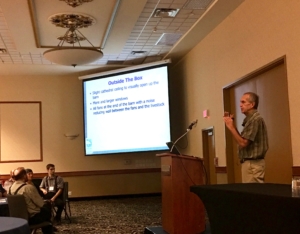As part of a group sow housing seminar held September 12th in Winnipeg, MB, and September 13th in Strathmore, AB Murray Elliot a farm building consultant with FGC Construction talked about the topic new or renovation, what to consider.
Meeting was entitled Building New or Renovation: What’s to Consider.
FGC, Swine Innovation Porc, and Prairie Swine Center held these meetings as a joint venture to give hog farmers a better handle on what to consider when making plans to expand.
“The focus is really to help people have a look at their current facilities. It can incorporate plans of what they hope to do in the future and put those two together to make a facility that meets the new code of practices and meets current production today,” said Elliot. “I have a background, with 20 years in production in managing a sow herd, plus 15 years with FGC Construction in the design and sales portion of the business. Again, Swine Innovation Porc and Prairie Swine are front and center in trying to bring these new codes to the producers, help get the information into their hands to make right decisions.”
Elliott said the reason pork producers are asking themselves whether to build new or to renovate, at this point is that by 2024 they need to implement the new codes. All the barns are certain to get old, too. The big building boom in the 90’s has made these facilities getting to be 20-30 years old. So, the current facilities are needing some help, and with some profits in the pork industry over the last two or three years, there is a bit more drive to make these improvements. Also, a new code comes into practice, so they’re trying to incorporate the whole nine yards at the same time.
How do the advantages differ between building from scratch and renovating?
“Building from scratch certainly is a huge advantage in that your new build is what you want it to be. You get to incorporate all your new ideas. All your increased farrowing and weaning days, the code, the extra square footage, and you get to put it in a nice neat package,” he said. “The downside is the cost tends to be higher than renovation. If you have a facility, and it’s in good shape, there’s certainly some value there that’s often possible to salvage. So, the advantage of a renovation is reduced cost and recovering your existing facility.”
When considering whether to build from scratch or renovating the first thing to look at is permitting because it means starting from scratch. It’s a green field project, and therefore all the minimum distances and all the new codes apply.
“When you go to renovations, often, you’re grandfathered in. So, that’s certainly a consideration. You need to have a good hard look at before you even start down the road of which way you’re going to go,” said Elliott. “The state of the current building is critical. You have to have a good hard look at the deficiencies of your building. You need to look at pits, at premier walls, at floors, slots, attics, and bases. You have to have a very critical look at your existing facility to determine how much value the building has.”
He said cost is the determining factor. A producer can often do a renovation for half the cost of new if an existing facility is in relatively good shape. Sometimes it goes quite a bit higher, and then he has to cross that bridge and decide it’s not worth it. But, indeed, with the new code, the current herd usually doesn’t fit inside the existing facility, and therefore, most renovations become renovations slash new builds, and there’s a new portion of the barn added.
“I guess what we’re seeing as the most common trend producers are building new farrowing barns and the old farrowing barns converted to dry sow, and the old dry sow converted to loose housing,” he said. “So, the existing farrowing tends to be two small five by seven crates. People are going to six by eight-floor space for farrowing. The weaning days, people want to add to that, usually, and that requires more farrowing crates. So, it’s a nice fit, if you can see your way clear at doing that.”
He said working with producers whether renovating or building from scratch has improved the production of the current owner. “So, once we move away and you talk to these guys a year or two later, they’re pleased. Production numbers have gone up. Weaning ages have gone up. It’s been relatively positive feedback, post build.” •
— By Harry Siemens




